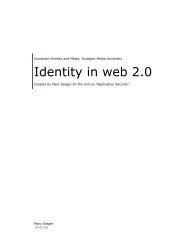The current state of anonymous file-sharing - Marc's Blog
The current state of anonymous file-sharing - Marc's Blog
The current state of anonymous file-sharing - Marc's Blog
Create successful ePaper yourself
Turn your PDF publications into a flip-book with our unique Google optimized e-Paper software.
2.3 Motivation: Freedom <strong>of</strong> speech / Freedom <strong>of</strong> the press<br />
<strong>The</strong> whole situation <strong>of</strong> free speech and a free press could be summarized by a famous<br />
quote <strong>of</strong> American journalist A. J. Liebling: Freedom <strong>of</strong> the press is guaranteed only to<br />
those who own one.<br />
While free speech and a free press are known to be a cornerstone <strong>of</strong> most modern civi-<br />
lizations (nearly every country in the western hemisphere has freedom <strong>of</strong> speech/freedom<br />
<strong>of</strong> the press protected by its constitution ), recent tendencies like the patriot act in the<br />
USA or the pressure on the media in Russia have shown that a lot <strong>of</strong> societies tend<br />
to trade freedom for a (supposed) feeling <strong>of</strong> security in times <strong>of</strong> terror or aren’t able<br />
to defend themselves against their power-hungry leaders. With fear-mongering media<br />
and overzealous government agencies all over the world, it might be a good idea to<br />
have some form <strong>of</strong> censorship resistant network which allows publishing and receiving<br />
<strong>of</strong> papers and articles in an <strong>anonymous</strong> manner and still allow the public to access the<br />
information within this network. Moreover, it should be possible to allow <strong>sharing</strong> <strong>of</strong><br />
textual content as well as video and audio. This tends to be difficult as <strong>file</strong> sizes <strong>of</strong> video<br />
and audio content are pretty big when compared to simple textual content.<br />
3 Technical Networking Background<br />
3.1 Namespaces<br />
To really understand the patterns which allow accessing networks in an <strong>anonymous</strong><br />
way, it is first necessary to understand the basic concepts <strong>of</strong> networks and the unique<br />
characteristics a PC possesses in any given network.<br />
<strong>The</strong>re basically are two things that identify a PC in a network:<br />
• <strong>The</strong> NICs 1 MAC 2 address (e.g. "00:17:cb:a5:7c:4f")<br />
• <strong>The</strong> IP address used by the PC to communicate (e.g. "80.131.43.29")<br />
Although a MAC address should be unique to a NIC and an IP addresses should be<br />
unique on a network, both <strong>of</strong> them can be altered. Both <strong>of</strong> them can be spo<strong>of</strong>ed to<br />
imitate other Clients or simply disguise the own identity. Spo<strong>of</strong>ing the MAC address <strong>of</strong><br />
another client that is connected to the same switch will usually lead to something called<br />
1 NIC: Network Interface Card<br />
2 MAC: Media Access Layer<br />
3



